| |||||
| Decades: | |||||
|---|---|---|---|---|---|
| See also: | Other events of 1879 History of Bolivia • Years | ||||
Events from the year 1879 in Bolivia.
| |||||
| Decades: | |||||
|---|---|---|---|---|---|
| See also: | Other events of 1879 History of Bolivia • Years | ||||
Events from the year 1879 in Bolivia.

The Antofagasta Region is one of Chile's sixteen first-order administrative divisions. The second-largest region of Chile in area, it comprises three provinces, Antofagasta, El Loa and Tocopilla. It is bordered to the north by Tarapacá, by Atacama to the south, and to the east by Bolivia and Argentina. The region's capital is the port city of Antofagasta; another one of its important cities is Calama. The region's main economic activity is copper mining in its giant inland porphyry copper systems.
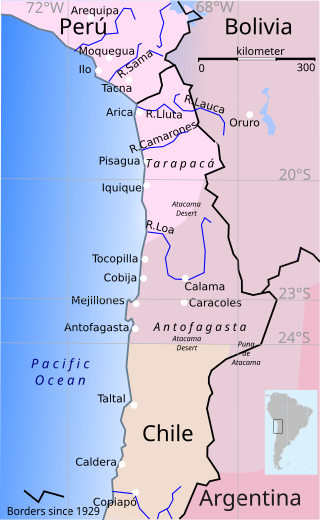
The War of the Pacific, also known as the Nitrate War and by multiple other names, was a war between Chile and a Bolivian–Peruvian alliance from 1879 to 1884. Fought over Chilean claims on coastal Bolivian territory in the Atacama Desert, the war ended with victory for Chile, which gained a significant amount of resource-rich territory from Peru and Bolivia.

Mejillones is a Chilean port city and commune in Antofagasta Province in the Antofagasta Region. Its name is the plural form of the Spanish mejillón meaning "mussel", referring to a particularly abundant species and preferred staple food of its indigenous inhabitants. It is situated in the northern side of the Mejillones Peninsula, 60 km north of the city of Antofagasta. To the west, in the northern part of peninsula, is Punta Angamos, the site of the naval combat of the same name, fought during the War of the Pacific (1879-1883).
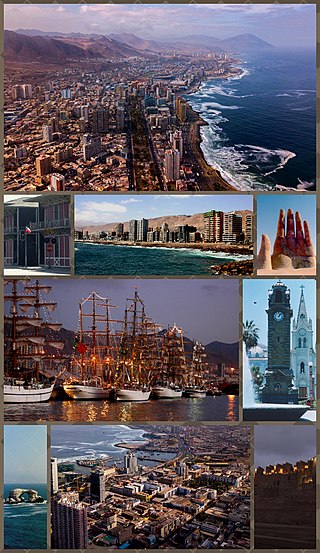
Antofagasta is a port city in northern Chile, about 1,100 kilometres (700 mi) north of Santiago. It is the capital of Antofagasta Province and Antofagasta Region. According to the 2015 census, the city has a population of 402,669.
Antofagasta plc is a London-based Chilean multinational. It is one of the most important conglomerates of Chile with equity participation in Antofagasta Minerals, the railroad from Antofagasta to Bolivia, Twin Metals in Minnesota and other exploration joint ventures in different parts from the world. Antofagasta is listed on the London Stock Exchange and is a constituent of the FTSE 100 Index.
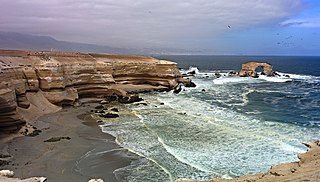
Antofagasta Province is one of three provinces in the northern Chilean region of Antofagasta (II). The capital is the port city of Antofagasta. Located within the Atacama Desert, it borders the El Loa and Tocopilla provinces to the north, the Pacific Ocean to the West and the Atacama Region to the south.
Ladislao Cabrera was a Bolivian hero during the War of the Pacific. Born in Totora, Cochabamba Department, Carrasco Province, he is famous for organising the defence of Calama against the Chilean invaders in the War of the Pacific.
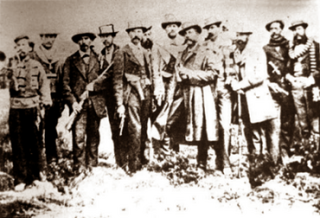
The Battle of Topáter, or Battle of Calama, was fought on March 23, 1879, between Chile and Bolivia. It was the first battle of the War of the Pacific.
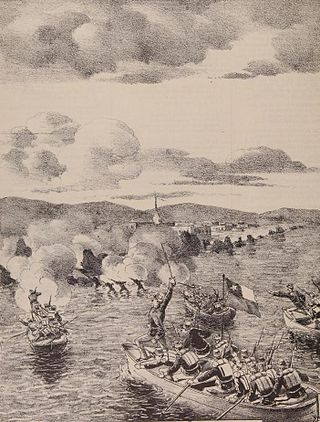
The Battle of Pisagua, was a landing operation of the War of the Pacific, fought on November 2, 1879, between Chile and the combined forces of Bolivia and Peru. The Chilean army commanded by Erasmo Escala, supported by the Chilean Fleet, launched an amphibious assault on the port of Pisagua and successfully drove the defending Bolivian-Peruvian forces, led by Gen. Juan Buendia, back from the shore. They established a beachhead that allowed an initial force of about 1,000 Chilean soldiers in two assault waves to disembark onto Peruvian territory at Pisagua in Tarapacá Department. This region was the principal territory in dispute.

Hilarión Daza was a Bolivian military officer who served as the 19th president of Bolivia from 1876 to 1879. During his presidency, the infamous War of the Pacific started, a conflict which proved to be devastating for Bolivia.

Chilean-Peruvian relations are the historical and current bilateral relations between the adjoining South American countries of the Republic of Chile and the Republic of Peru. Peru and Chile have shared diplomatic relations since at least the time of the Inca Empire in the 15th century. Under the Viceroyalty of Peru, Chile and Peru had connections using their modern names for the first time. Chile aided in the Peruvian War of Independence by providing troops and naval support.

The Puna de Atacama or Atacama Plateau is an arid high plateau, in the Andes of northern Chile (15%) and northwest of Argentina (85%). Geomorphologist Walther Penck based his Grossfalt landform association on Puna de Atacama.
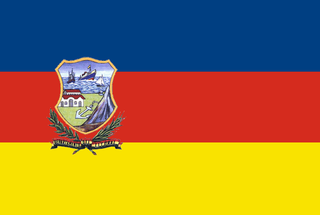
The Department of the Litoral, also known as the Atacama Department and commonly known as the Bolivian coast, was the description of the extent of the Pacific coast of the Atacama Desert included in the territory of Bolivia from its inception in 1825 until 1879, when it was lost to Chile.

The Naval campaign of the War of the Pacific or Saltpeter war, was a naval campaign that took place from 1879 to 1884, involving Peru, and Chile, undertaken in order to support land forces in the Atacama Desert. Although the conflict lasted until 1884, the primary naval engagements occurred between 1879 and 1880. Due to the rough terrain and few transport methods it was imperative to have control of the ports in order to have a good supply source in the region. It resulted in a successful campaign by Chile, and the success of their land campaigns eventually led to a Chilean victory, which cut off Bolivia's access to the coast.
The 1877 Iquique earthquake occurred at 21:16 local time on 9 May. It had a magnitude of 8.5 on the surface wave magnitude scale. Other estimates of its magnitude have been as high as 8.9 Mw and 9.0 Mt. It had a maximum intensity of XI (Extreme) on the Mercalli intensity scale and triggered a devastating tsunami. A total of 2,385 people died, mainly in Fiji from the tsunami.
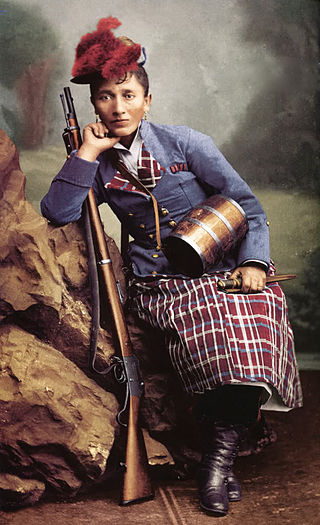
Irene Morales Infante was a Chilean soldier who served in the War of the Pacific. She was born in a barrio of Santiago, and lived in poverty throughout her life, working as a seamstress from an early age. When the War of the Pacific began she was only 13 years old, and had been orphaned and twice widowed. Her second husband was executed by the Bolivian military for killing a soldier.

The Treaty of Valparaiso was an agreement between Chile and Bolivia that ended the War of the Pacific. Signed on April 4, 1884, the third treaty of the war forced Bolivia to give Antofagasta to Chile.

The Boundary Treaty of 1874 between Chile and Bolivia, also called the Treaty of Sucre, was signed in Sucre on August 6, 1874 by the Bolivian Minister of Foreign Affairs Mariano Baptista and the Chilean plenipotentiary minister Carlos Walker Martínez. It superseded the Boundary Treaty of 1866 between Chile and Bolivia, establishing the border between both countries at the 24° South parallel from the Pacific Ocean to the eastern border of Chile.
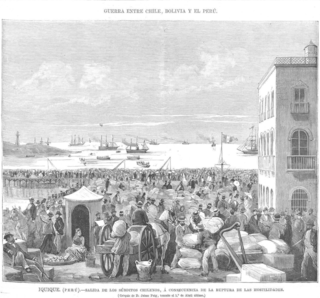
The Expulsion of Chileans from Bolivia and Peru in 1879 was an ethnic cleansing ordered by of the governments of Bolivia and Peru. The expulsion took place at the beginning of the War of the Pacific (1879–1883) between Chile and Peruvian-Bolivian alliance. Chilean citizens in both nations were ordered to leave within eight days or face internment and confiscation of their property. They were expelled on poorly-built rafts and pontoons at Peruvian ports, or forced to wander through the desert to reach the northernmost positions occupied by the Chilean Army in Antofagasta. The edict was widely popular in Peru and met with little resistance, allowing it to occur quickly.

The Battle of Río Grande was a minor military engagement that took place on 10 September 1879, during the War of the Pacific. A picket of Chilean soldiers and a Bolivian montonera clashed in Rio Grande, around San Pedro de Atacama. Bolivians are defeated, which eliminates local resistance to Chilean occupation in the Litoral Department.